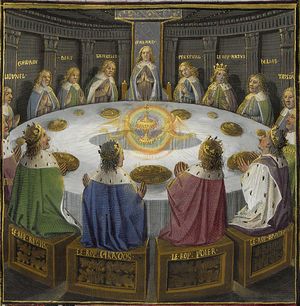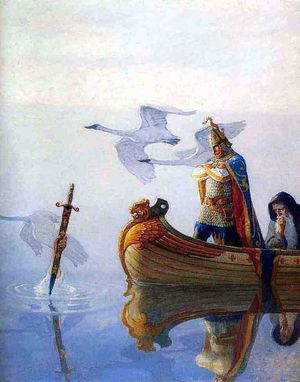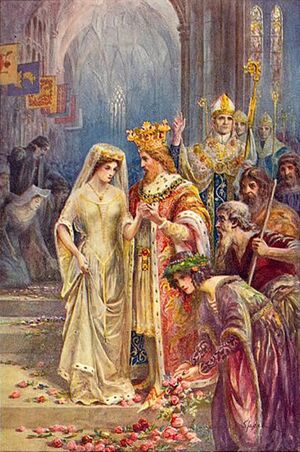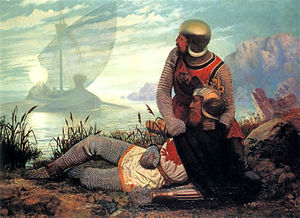King Arthur: Difference between revisions
PeterDuffy (talk | contribs) (Marked this version for translation) |
PeterDuffy (talk | contribs) (Added image, link) |
||
| Line 60: | Line 60: | ||
<!--T:22--> | <!--T:22--> | ||
It was Merlin who went before King Leodegrance to announce the desire of Arthur to wed his daughter Guinevere. He returned triumphantly to Camelot with Lady Guinevere and the Round Table, a gift to Leodegrance from Arthur’s father, Uther Pendragon. | It was Merlin who went before King Leodegrance to announce the desire of Arthur to wed his daughter Guinevere. He returned triumphantly to Camelot with Lady Guinevere and the Round Table, a gift to Leodegrance from Arthur’s father, Uther Pendragon.</translate> | ||
[[File:The marriage of king arthur by lancelot speed.jpg|thumb|<translate>''The Marriage of King Arthur'', Lancelot Speed</translate>]] | |||
<translate> | |||
== Camelot == <!--T:23--> | == Camelot == <!--T:23--> | ||
<!--T:24--> | <!--T:24--> | ||
At Camelot, King Arthur called together men and women of the highest attainment from throughout the realm and formed the Order of the Knights of the Round Table. Their raison d’être: the quest for the Holy Grail, the defense of the Mother principle, eternal brotherhood under the Eternal Father, the restoration of Christ’s kingdom on earth, the protection of the flame of the Holy Spirit in the community of Arthur’s court and its extension throughout Britain, and the ennoblement of the soul through devotion to the Christ in individualized community action. | At Camelot, King Arthur called together men and women of the highest attainment from throughout the realm and formed the Order of the Knights of the Round Table. Their raison d’être: the quest for the [[Holy Grail]], the defense of the Mother principle, eternal brotherhood under the Eternal Father, the restoration of Christ’s kingdom on earth, the protection of the flame of the Holy Spirit in the community of Arthur’s court and its extension throughout Britain, and the ennoblement of the soul through devotion to the Christ in individualized community action. | ||
<!--T:25--> | <!--T:25--> | ||
Revision as of 22:32, 3 January 2023

The “once and future king,” fifth- or sixth-century King of the Britons and Guru of the mystery school at Camelot, an embodiment of El Morya. He drove the Saxon invaders from Britain, united the kingdom and established the order of the Knights of the Round Table, whose code of chivalry bound them to defend the helpless from the wicked and evildoers and to uphold the ideals of purity, truth, mercy, faithfulness and generosity.
Arthurian legends
Between the eleventh and fourteenth centuries, Arthurian legends attained the height of their popularity. Minstrels and troubadours carried the fame of Arthur all over Europe. Historians told of his valiant deeds in prose, and poets in verse, while artists adorned the halls, tapestries and stained-glass windows of many castles with scenes depicting the adventures of King Arthur and the knights and ladies of the Round Table.
The story of Arthur as presented in Sir Thomas Malory’s Morte d’Arthur is considered a masterpiece. Malory wrote his great work from behind bars during the Wars of the Roses (1455–86). This single book revived a vivid interest in the life of Arthur, his noble deeds, and those of his knights.
Coincidentally, in the year Malory’s book was published, Henry VII, the new king of England, announced that he himself was a descendant of King Arthur. He stated that his son, whom he named Arthur, was the fulfillment of Merlin’s prophecy—Arthur had returned to rule England.
The next great revival of interest in Arthur and his court of Camelot came as a result of the publication of the Idylls of the King by Alfred Lord Tennyson in 1842. The work was so popular throughout all the English-speaking world, that by 1890 it was taught in all public schools in the United States.
The historical King Arthur
The historical King Arthur is said to have lived about 500 A.D., and is thought to have been a leader of the Britons in their battles against the invading Anglo-Saxon kings. Malory and Tennyson both record that he fought and defeated twelve kings. Arthur was so wise a leader and performed so many deeds of valor that he became a hero to his countrymen for all time.
Some historical evidence of Arthur’s life comes from Glastonbury Abbey. Some of the priests who served there during the sixth century preserved a record of their receipt of the disinterred bodies of both King Arthur and his queen, Guinevere. The bodies of the royal couple were buried beneath the high altar in the church.
According to an account by Giraldus Cambrensis, who was present when the grave was opened at the command of Henry II about the year 1150, the grave contained the bones and sword of King Arthur. It also contained a leaden cross which contained the following inscription: Here lies buried the famous King Arthur, in the island of Avalon.
The birth of Arthur
According to Malory, Arthur was born to Uther Pendragon, “king of all England,” and noble Queen Igraine at Merlin’s own bidding with the understanding that the child would be delivered to Merlin as soon as he was born. And so the tiny newborn babe bound in a cloth of gold was brought to the “poor man” at the postern gate of the castle and taken to Sir Ector, whose wife nourished him at her own breast. Merlin called a holy man to christen him and named the child Arthur.
Within two years, while King Uther lay mortally ill, his enemies “did a great battle upon his men and slew many of his people.” Merlin bade the king to ride into the battlefield on a stretcher, for “if your person be there ... then shall ye have the victory.” So it was at St. Albans that Uther’s men overcame the “great host of the North.”
The dying king returned to London, where Merlin called together all the barons of Uther’s realm in order that the king might name his heir. And Merlin said aloud, “‘Shall your son Arthur be king after your days?’” And Uther answered, “‘I give him God’s blessing and mine’ ... wherewith he yielded up the ghost.”

The sword in the stone
The land of England stood then “in jeopardy a long while,” for many rose up attempting to capture the crown by force. So Merlin went before the Archbishop of Canterbury and counseled him to call all the lords of the realm to London at Christmas in order that Jesus, born King of Kings, might come to show who should rule England.
By the alchemy of the Christ consciousness, Merlin caused the sword and the stone to appear in the churchyard of Canterbury cathedral with these words: “Whosoever pulleth out this sword of this stone and anvil, is rightwise king born of all England.” By the trial of the sword—representing the power of the soul that is free from the bondage of attachment to things material symbolized by the stone and anvil—Arthur proved his kingship.
The trial of the sword represents the power of the soul that is free from the bondage of attachment to things material, symbolized by the stone and anvil. It is an illustration of the divine right of kings—he who has the greatest attainment of the Christ consciousness has the right to rule. Knights and warriors, kings and noblemen gathered from throughout the western world, but Arthur alone, a lad of twelve, could free the sacred sword. He was crowned King of England by the Bishop of Canterbury.
Thereafter, Merlin remained at Arthur’s side as counselor and friend. The young king once would have died by the sword of mighty Pellinore had not Merlin appeared and “cast an enchantment” upon the knight. It was because Arthur’s sword was smitten in two during that fierce joust that Merlin and Arthur rode to the lake where they miraculously beheld rising from the water the arm of the Lady of the Lake holding the magnificent sword Excalibur. Merlin later counseled him, “Look ye keep well the scabbard of Excalibur for ye shall lose no blood while ye have the scabbard upon you”—a prediction well fulfilled in future years.
It was Merlin who went before King Leodegrance to announce the desire of Arthur to wed his daughter Guinevere. He returned triumphantly to Camelot with Lady Guinevere and the Round Table, a gift to Leodegrance from Arthur’s father, Uther Pendragon.

Camelot
At Camelot, King Arthur called together men and women of the highest attainment from throughout the realm and formed the Order of the Knights of the Round Table. Their raison d’être: the quest for the Holy Grail, the defense of the Mother principle, eternal brotherhood under the Eternal Father, the restoration of Christ’s kingdom on earth, the protection of the flame of the Holy Spirit in the community of Arthur’s court and its extension throughout Britain, and the ennoblement of the soul through devotion to the Christ in individualized community action.
The knights of the Round Table and the ladies of the court at Camelot were initiates of a mystery school of the Great White Brotherhood. In the tradition of the Pythagorean school at Crotona, the Essene community at Qumran, the mandala of Christ and his apostles, as well as the guilds of medieval Europe that would succeed them, the knights and ladies guarded the inner truths of the Brotherhood revealed to them by Merlin. The jousting and competition of the knights in their tournaments was the measuring of levels of inner soul attainment.
The devotion of King Arthur and Queen Guinevere in their soul relationship of guru and chela was the focus of the flame of the Father-Mother God in the center of the court. The coming of Launcelot du Lac, also a chela of Arthur, to the Order of the Knights of the Round Table was the drawing together of the three persons of the Trinity, the threefold flame in the heart of Camelot. The soul relationship of Launcelot and Guinevere was that of twin flames. Together Arthur, Guinevere, and Launcelot laid the foundation of the Christian/Piscean dispensation for the English-speaking peoples.
Arthur led his knights in the quest for the Holy Grail, the cup from which Jesus drank at the Last Supper. After his ascension, the Grail cup was deposited in a well at Glastonbury by a group of disciples who, together with Mary the Mother and Joseph of Arimathea, journeyed by boat from the Holy Land to establish shrines on the European continent and in the British Isles for the expansion of western Christendom during the next two-thousand-year cycle.
Thus El Morya, anointed by God (through Merlin, the reincarnated Prophet Samuel, anointer of kings and prophets unto the people Israel), attuned with the Grail focus and by his noble ideals and spiritual genius, built the platform for the dissemination of the Christic light throughout the globe wherever the British went forth by its impetus to discover and settle new worlds. The inner significance of the knight initiates of the brotherhood of the quest was seeking and finding the Christ consciousness through the law of self-disciplined service to life.

Arthur’s passing
Among the knights of the Round Table, Sir Modred (said to have been Arthur’s son sired prior to his marriage) harbored intense jealousy and hatred for the king. Knowing that the military strength of Arthur was unsurpassed, he contacted the sorceress, Morgana le Fay, and together Modred and Morgana used the subtle entrapments of witchcraft, treachery, and intrigue to destroy the sacred trust of king, queen, and knights of the Round Table. In a war that resulted from the denial of a Roman demand for tribute, Arthur would have conquered Rome itself and the entire empire if he had not been called back to England where Modred had usurped the throne and imprisoned Queen Guinevere in the Tower of London. In the fierce Battle of Camlam that followed, Arthur slew Modred but was mortally wounded.
According to Arthurian legends, he was placed on a barge with three queens which drifted toward Avalon, an “island valley,” where, as Alfred Lord Tennyson wrote in Idylls of the King, “falls not hail, or rain, or any snow, nor ever wind blows loudly; but it lies deep-meadow’d, happy, fair with orchard lawns and bowery hollows crown’d with summer sea.” Some accounts say that Arthur would be healed of his “grievous wound” at Avalon and would return to rule over his people.
Sir Thomas Malory writes in Le Morte d’Arthur:
Yet some men say in many parts of England that King Arthur is not dead, but had by the will of Our Lord Jesu [withdrawn] into another place; and men say that he shall come again, and he shall win the holy cross. I will not say that it shall be so, but rather I will say, here in this world he changed his life. But many men say that there is written upon his tomb this verse: Hic iacet Arthurus, rex quondam rexque futurus [Here lies Arthur, the once and future king].
The return of Arthur
Many Englishmen believed that Arthur never died. He was for them a sort of guardian angel, watching over his people from his home on the Isle of Avalon. In times of acute crisis, they believed Arthur would return to lead England to victory.
We also believe that the saint who became Thomas Becket and Thomas More was the reincarnated soul of Arthur, and that he, now ascended, is our own Guru and teacher who shows us the way of the will of God according to the path of Christ.
The Heart of the Inner Retreat is as “Avalon” where chelas of El Morya retreat in summer to be healed of the blows of karmic adversity affecting body, mind and soul. And the master himself takes refuge in this Western Shamballa—Gautama Buddha’s etheric/physical retreat in the West, an extension of his retreat over the Gobi Desert, which is centered over “the Heart” of this island valley.
See also
Sources
El Morya, The Chela and the Path: Keys to Soul Mastery in the Aquarian Age
Pearls of Wisdom, vol. 31, no. 34, July 2, 1988.
Pearls of Wisdom, vol. 28, no. 51, December 22, 1985.
Elizabeth Clare Prophet, May 22, 1983.
Elizabeth Clare Prophet, April 21, 1984.
